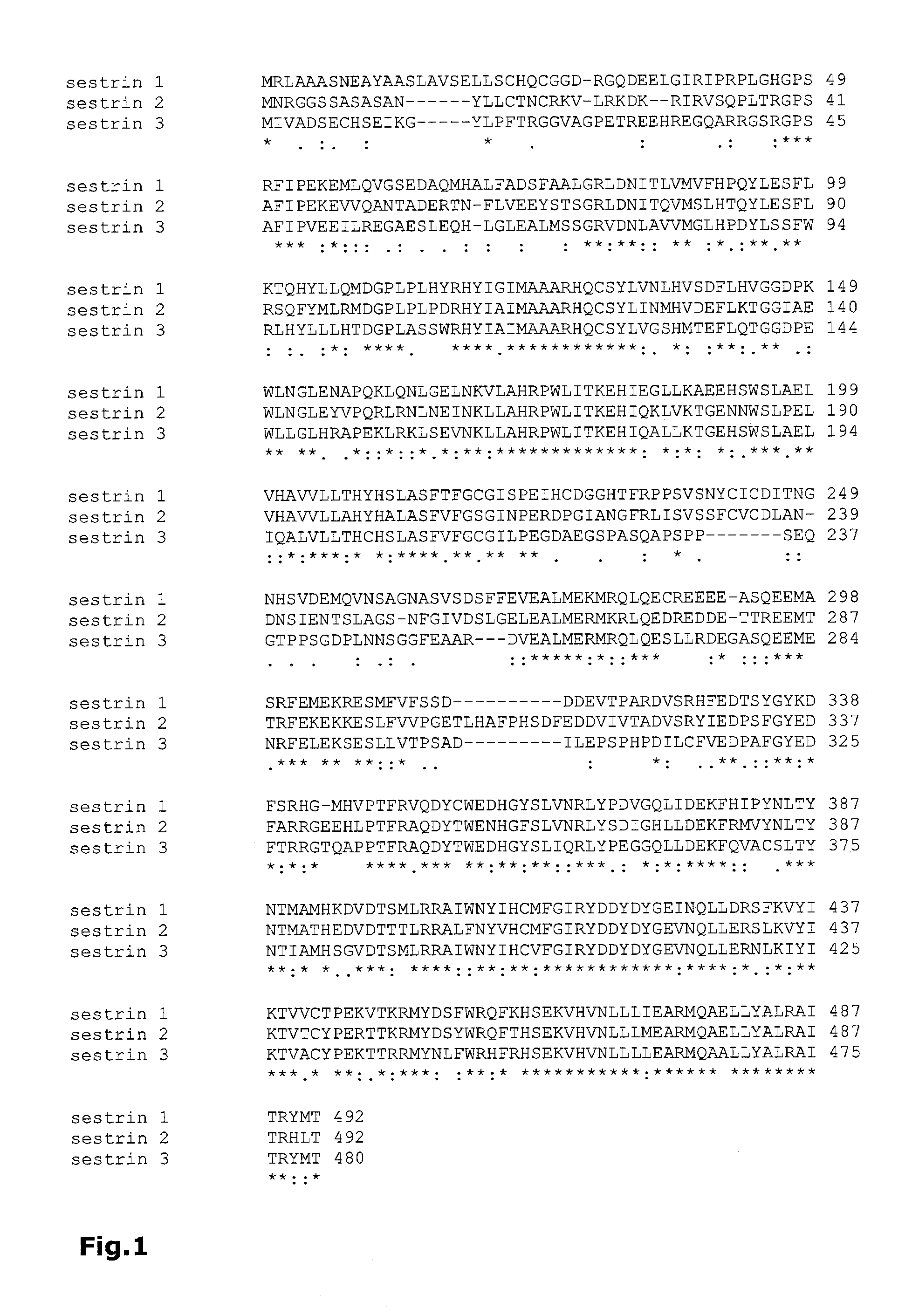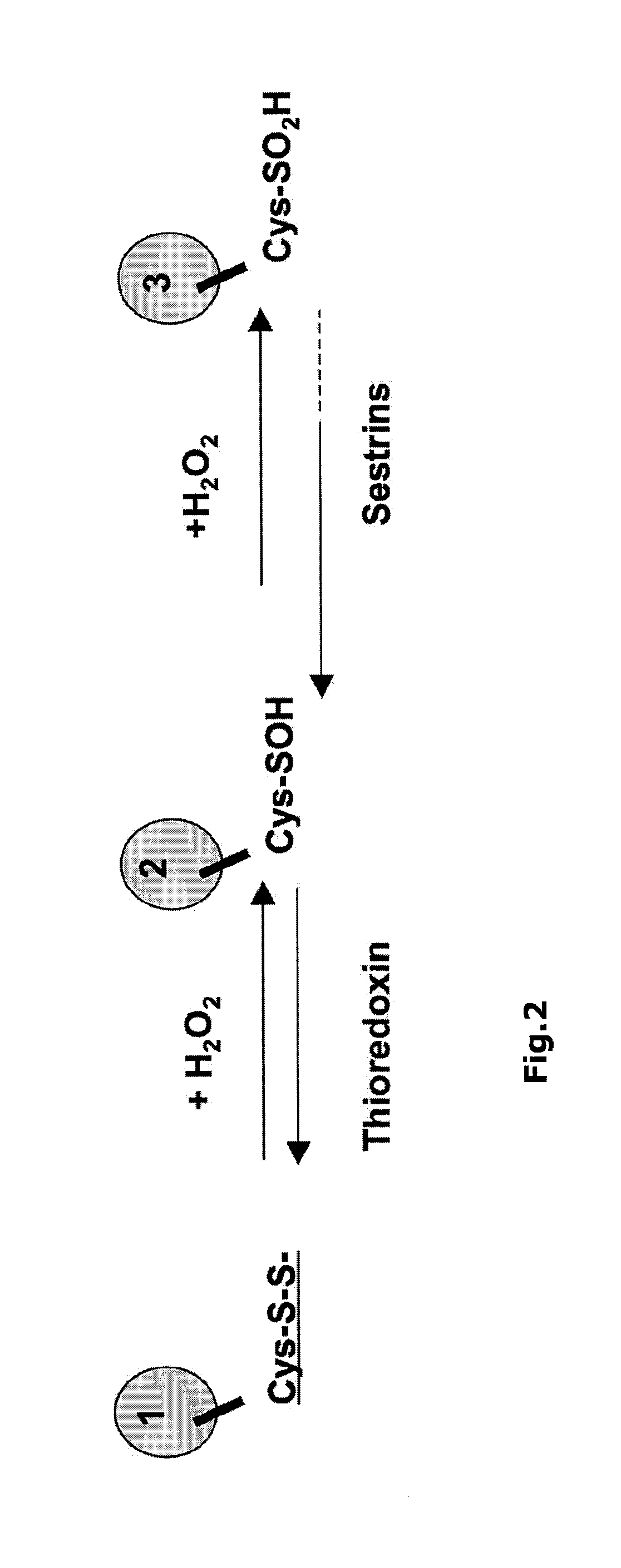Animal model for the selection and validation of agents active against pulmonary emphysema and colorectal cancer
- Summary
- Abstract
- Description
- Claims
- Application Information
AI Technical Summary
Problems solved by technology
Method used
Image
Examples
example 1
A pT1βgeo Gene Trap Insertion in the Sestrin 2 Gene Induces a Null Mutation in Transgenic Mice
[0074]The WO77E06 gene trap ES cell line was obtained by electroporating the pT1βgeo gene trap vector shown in SEQ ID NO:10 into TBV-2 (129SvPas) ES cells as previously described (Floss, T. & Wurst, W. Methods Mol Biol 185, 347-79, 2002). Gene trap expressing ES-cell clones were selected in 200 μg / ml G418 (Gibco / BRL), manually picked, expanded, and stored frozen in liquid nitrogen. The gene trap insertion in the 9th intron of the sestrin 2 (sesn2) gene was identified among the recovered clones by 5′ RACE as described in the Methods section and by sequence database analysis (Genbank at http: / / www.ncbi.nlm.nih.gov) using the BlastN algorithm. The gene trap insertion in the WO77E06 cell line was verified by genomic PCR (see Methods) using the following primers complementary to gene trap- and adjacent upstream intron sequences: 5′-CAGCCTTGAGCCTCTGGAGC-3′ (SEQ ID NO:11) and 5′-CTACCCTGAGAAGACGAC...
example 2
Sesn2 Null Alleles Improve the Pulmonary Emphysema in Ltbp4− / − Mice
[0079]129 / Sv (D3) ES cells with a U3Cre gene trap vector (SEQ ID NO:16) insertion in the 5th intron of the ltbp4 gene were injected C57BL / 6 blastocysts as previously described (WO 03 / 015505, Thorey, I. S. et al. Mol Cell Biol 18, 3081-3088, 1998). The resulting male chimeras were bred to C57BL / 6 females and agouti offspring were tested for transgene transmission by tail blotting. Mouse tail DNA was cleaved with BglII which does not cut provirus. The DNA was fractionated on 1% agarose gels, blotted onto Hybond N nylon filters (Amersham / Pharmacia, Piscataway, N.J.) and hybridized to a 32P labeled provirus flanking sequence probe. Animals heterozygous for the gene trap insertion were backcrossed to C57BL / 6 mice for at least six generations before analyzing the phenotypes in heterozygous and homozygous offspring. To obtain double mutant strains, heterozygous ltbp4+ / − mice were crossed to homozygous sesn2− / − mice and the ...
example 3
Sesn2 Null Alleles Improve the Rectal Prolapse and Colorectal Adenomas in Ltbp4− / − Mice
[0083]FIG. 13 shows a typical colorectal an adenoma of 3 months old ltbp4− / − (WO 03 / 015505 A3) mouse. Microscopically, the region exhibited abberant crypt foci containing regenerating epithelial cells and an increased number of goblet cells. Although double mutant ltbp4− / −sesn− / − littermates also exhibited adenomas, these were significantly smaller in size and contained fewer goblet cells (FIG. 11), suggesting a partial phenotypic rescue. Since the ltbp4− / − phenotype is essentially caused by defective TGF-fβ activation (Sterner-Kock A., et al. Genes Dev. 16:2264-2273, 2002), we tested whether the partial rescue was associated with a reactivation of TGF-fβ signaling. Towards this end we determined the levels of phosphorylated smad2 in tissue sections by immunohistochemistry. Consistent with an activation of TGF-fβ signaling in ltbp4− / −sesn2− / − mice, p-smad2 levels were very high in contrast to the ...
PUM
| Property | Measurement | Unit |
|---|---|---|
| Length | aaaaa | aaaaa |
| Length | aaaaa | aaaaa |
| Cell angle | aaaaa | aaaaa |
Abstract
Description
Claims
Application Information
 Login to View More
Login to View More - R&D Engineer
- R&D Manager
- IP Professional
- Industry Leading Data Capabilities
- Powerful AI technology
- Patent DNA Extraction
Browse by: Latest US Patents, China's latest patents, Technical Efficacy Thesaurus, Application Domain, Technology Topic, Popular Technical Reports.
© 2024 PatSnap. All rights reserved.Legal|Privacy policy|Modern Slavery Act Transparency Statement|Sitemap|About US| Contact US: help@patsnap.com










